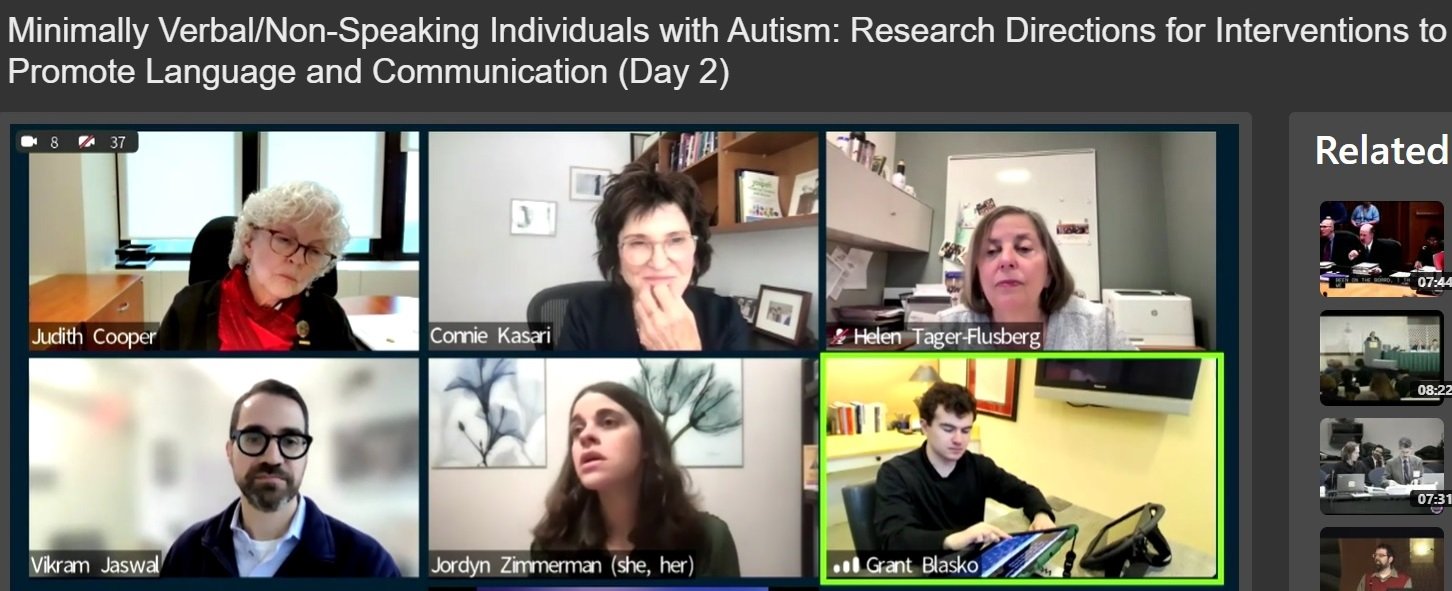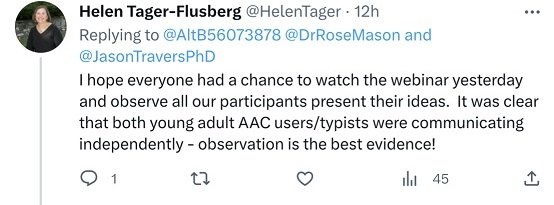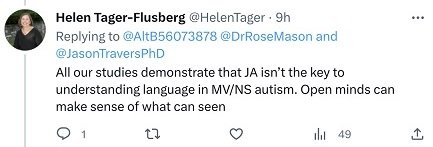Cross posted at FacilitatedCommunication.org.
A couple of weeks ago, Autism Science Foundation founder Alison Singer posted on Twitter a video of an exchange she had with Cure Autism Now founder Jonathan Shestack. The clip opens with a question from Singer:
You’ve been away from the autism advocacy world for some years, but what’s your feeling about how the definition of autism spectrum disorder has changed?
Singer was alluding to the expansion of the autism spectrum to include what was once called Asperger’s Syndrome. This expansion assigns people with a range of speaking and writing abilities—some fully fluent, others completely minimally verbal—to the same diagnostic category. Back in 1995, when Shestack and his wife, Portia Iversen, founded Cure Autism Now (now Autism Speaks), autism and Asperger’s were distinct diagnoses.
Shestack, answering Singer’s question, implicitly raises another:
I feel like when the diagnosis got collapsed the identity of my son, who is super-duper autistic, you might say profoundly autistic, got sort of lost in the shuffle and people were wondering like does he have any special skills, how does he feel about this, and my concern was always like is someone going to make sure that he’s warm and takes him to the bathroom and has enough to eat and while I think all this awareness is really good, I feel like he and those like him, and there are a lot, got sort of lost in the shuffle and I feel sad about and I have to probably talk about that more.
Indeed he does. In particular, he’s left many of us wondering about whatever happened to Dov Shestack.
Dov, the son of Jon Shestack and Portia Iversen, is one of the two sons featured in Iversen’s 2007 autism memoir Strange Son: Two Mothers, Two Sons, and the Quest to Unlock the Hidden World of Autism. Both Dov and the other titular son, Tito Mukhopadhyay, purportedly had high levels of language, literacy, and other academic skills that were unlocked by a form of facilitated communication invented by Tito’s mother, Soma Mukhopadhyay. This variant of FC, known as the Rapid Prompting Method, has been proliferating around the country and mutating into new variants ever since.
But while Soma and Tito are still in action, the last public sightings of Dov date back to 2015.
Nor is Dov not the only FC star who’s disappeared. In the realm of traditional FC, there are Sharisa Kochmeister and Amy Sequenzia. Then there’s Carly Fleischman, whose typing has never been publicly acknowledged as facilitated but, in the one video in which we see her typing more or less spontaneously, has all the trappings of RPM-style facilitation: slow, index finger typing; a designated assistant sitting next to her, watching that index finger, and prompting her; and some significant reliance on word prediction.
All of these individuals—and a few other once-prominent FC users—have disappeared, mostly under mysterious circumstances.
In some ways, the least mysterious disappearance is that of Sharisa Kochmeister. Kochmeister, who was assessed via FC to have a genius-level IQ , earned an honors degree in psychology and sociology from Denver University, served as president of the Autism National Committee and on the executive committee for the Colorado Developmental Disabilities Council, and appeared in the autism documentary Loving Lampposts. Her disappearance dates back to 2015 and was reported in the Denver Post. Her father, who served as her sole facilitator, was caught on video pushing her at a doctor’s appointment. She was promptly removed from his custody and has been kept in a Colorado facility ever since. But well before 2015, Kochmeister had actually already retreated from public view. Her last blog posts date back to 2008; her professional activities, as reported on her LinkedIn page, end in 2010.
At least as intriguing is the disappearance of Amy Sequenzia. Sequenzia, also active starting in the early 2000s, was a contributor to the Autistic Women & Nonbinary Network and to an FC anthology (Typed Words, Loud Voices), and also the (credited) author of a poetry collection (My Voice: Autism, Life and Dreams). She also served on the board of the Autistic Self Advocacy Network, on the board of directors at the Florida Alliance for Assistive Services and Technology, and (like Kochmester) on the Autism National Committee. She has presented at numerous autism events and addressed the Florida Legislature.
But in late 2018, autistic advocate Caroline Hearst expressed some concerns on Twitter about (1) who was authoring Sequenzia’s messages and (2) how she was being treated by her handlers:

Shortly after that, Sequenzia essentially vanished. By early 2019, the Autism Self-Advocacy Network’s list of board members no longer included her name; Ollibean, the disability website, stopped carrying the regular blog posts that were credited to her. The last of these, from April 18th, 2019, looks like this:

If you click on “Read More”, you see a 500+ word post that ends with the words “Being silent is not the same as not feeling.” And what follows this post is years of total silence.
But then suddenly this January, after a nearly four-year hiatus, that changes—sort of. Two new posts appear: one on January 12th, and another on January 13th. Unaccompanied by images, they look like this:

That’s it. Aside from what look like meaningless strings of numbers and letters in the both the blog titles and the first lines of the posts, there’s nothing more. There are no other lines of text in these posts. And there are no updates whatsoever since they were posted this January.
What about Carly Fleischmann? Featured in 2012 on ABC’s 20-20, and the (credited) co-author of the 2012 book Carly’s Voice: Breaking Through Autism, Fleischmann disappeared not once, but twice. The first disappearance, according to multiple reports including this one from AutismAwareness.com, occurred in early 2014 after Fleischmann underwent electroconvulsive therapy (ECT). This purportedly led to significant language loss, as seen, for example in this twitter post:

It was over two years before Fleischmann returned to the public eye. And return she did. By 2017, she had a YouTube channel where, via pre-recorded questions (cheeky content in a text-to-speech monotone), she interviewed celebrities. This shtick proved so popular that in 2018 she made two TV appearances with Stephen Colbert (on HBO’s Night of Too Many Stars and on The Late Show).
But in early 2019 Fleischmann disappeared again. This occurred immediately after the following developments:
a post from her Facebook account accusing her father’s boyfriend of assaulting her
another post, appearing both on Twitter and on Facebook, saying that she had taken down the first post because of safety concerns
another post on Twitter saying that her account had been hacked


It’s been radio silence since then. Nothing on Facebook, nothing on Twitter, nothing on her YouTube channel, and nothing on TV.
Other disappearances, if not as intriguing, are equally mysterious. There’s Sue Rubin, mostly seen typing, RPM style, on a held-up keyboard; Ben Alexander, a classic, touch-based FC user; and Emma Zurcher-Long, an RPM user and erstwhile client of Soma Mukhopadhyay.
Rubin, like Kochmeister, has obtained genius-level IQ scores via FC. She was featured in the 2004 documentary Autism is a World. In 2013 she graduated from Whittier College with a BA in Latin American History. While Rubin has remained active on Facebook and has a stub page promoting her consulting business, her last public appearances, according to her one other website, date back to 2013.
Ben Alexander made headlines in 2016 in an AP story about his matriculation at Tulane University, where, with wrist support from his father, he was majoring in English with a 3.7 GPA. Alexander made a somewhat smaller splash in the Tulane News in 2018 when he graduated. Five years on, there’s been no more news.
Emma Zurcher-Long entered the public eye in 2017 when she was credited with directing the movie Unspoken at age 14. Her last blog post, after years of blogging, went up in late 2017; her last post on Twitter and her last public video date back to 2019. This, despite the fact that Unspoken was screened by the Slamdance Film Festival in 2021.
Other disappearances include Lucy Blackman of Australia, Alberto Frugone of Italy, Mark Gordon of Canada. As Charles Hart reports in A Parent’s Guide to Autism, Artie Shaslow, the son of Nobel Prize winning physicist Arthur Shaslow, stopped communicating after the death of his mother, his only facilitator (p. 175).
All this raises questions of what it takes to sustain the illusion over the long haul. Parents age and die; before that, kids age out of school. School is perhaps where parents—all parents—feel the greatest pressure for our kids to compare favorably with their peers; where we sense the greatest scrutiny from our peers about how our kids stack up. Perhaps for some parents—regardless of diagnosis or lack thereof—it’s enough if everyone else thinks their children are geniuses, whether or not they truly believe this themselves. Later on, as kids disperse and bigger issues loom, all of this matters less and less.
So let’s return to Dov. What happened to him?
Here’s where he was back in 2003:
Dov Shestak was one of [Soma’s] first students, since it was his parents, Portia and Jon, whose foundation brought Soma to the United States, but they never expected this… After years of trying nearly every technique available for autistic children, his parents were astonished. Within six weeks of working with Soma, suddenly came full sentences, complex thoughts and words spelled correctly…They learned that Dov is interested in religion and history and is a surprisingly good mathematician… We asked Dov how he had learned so much when no one had formally taught him… He told us that all those years when people thought he was lost in his own world, he was actually listening to everything around him.
Compare this to the Dov described by Jon Shestack 20 years later: a profoundly autistic adult for whom the greatest priorities are food and shelter.
The above excerpt is from a transcript of a 60 Minutes segment entitled “Breaking the Silence”, hosted by Vicky Mabrey. In Strange Son, Iversen recounts how she and her husband leveraged their media connections to bring about what turned out to be a tremendous publicity boost for RPM. The segment showcased Soma, Tito, and the miracle of RPM, and included words of wisdom from neuroscientist Michael Merzenich.
MABREY Do you think that Tito is just one in a million?
DR. MERZENICH I think there could be thousands of–maybe tens of thousands of Titos out there.
MABREY Scientists will soon find out if that’s true. For the past year, Soma’s been testing her homegrown methods on a small group of children at the Carousel school in Los Angeles, the school attended by Jon and Portia’s son, Dov.
Indeed, the miracles experienced by Dov back then extended to his fellow classmates at the Carousel school, all of whose intact language, literacy, and academic skills were being unlocked by Soma’s RPM.
But we never learn what scientists find out about how many Titos there are. And we never find out what happened to Dov’s classmates.
Nor is it clear whether the Carousel School is still practicing RPM. On one hand, their website still mentions Informative Pointing, Portia Iversen’s variant of RPM, as one of its many methods of communication. In describing the variety of communication tools it uses, it also references (linking to video that was removed long ago) RPM user Dylan Barnach:
Here’s an article about how the iPad has helped 16-year-old Dillan Barmache, who has autism and is non-verbal as part of a new campaign by Apple for April’s Autism Awareness.
On the other hand, when I twice submitted a form on the Carousel website inquiring about RPM, I received no reply.
There have been rumors that Jon Shestack and Portia Iversen no longer think that RPM has unlocked what Iversen, in Strange Son, called Dov’s “intact mind.” But Shestack’s reply to Alison Singer is the closest we’ve ever gotten to a public admission.
As I wrote in an earlier post on Portia’s memoir:
No one who once believed in miracles is obligated to keep doing so. But those who’ve persuaded thousands upon thousands to believe in miracles that they themselves have abandoned have incurred a heavy debt. Willing themselves to pay it off: now that would be truly miraculous.









